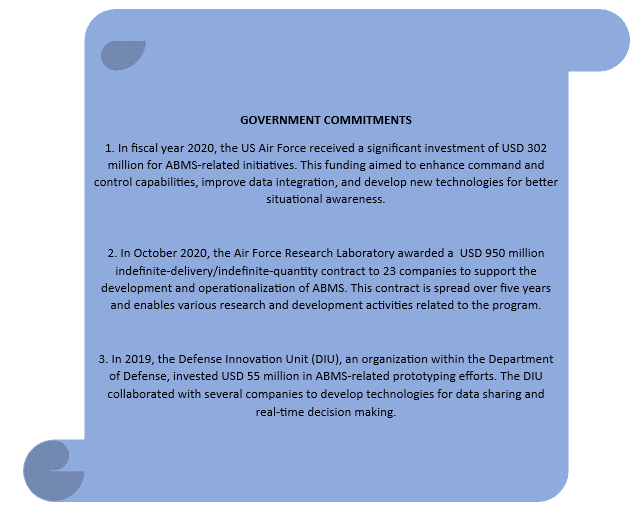- Home
- About Us
- Industry
- Services
- Reading
- Contact Us
US Advanced Battle Management System (ABMS) Market Seen Soaring 21.3% Growth to Reach USD 3.4 Billion by 2030, Projects Univdatos Market Insights
Author: Vikas Kumar
November 17, 2023
According to a new report by Univdatos Market Insights, Advanced Battle Management System (ABMS) Market, is expected to reach USD3.4 billion in 2030 by growing at a CAGR of 21.3%. ABMS aims to modernize and integrate the U.S. military’s command and control systems. It leverages cutting-edge technologies such as artificial intelligence, data analytics, cloud computing, and advanced communication networks. The rapid pace of technological advancements and the growing capabilities of these technologies can significantly contribute to ABMS’s growth. For example, advancements in AI can enable more efficient data processing and decision-making in real-time combat scenarios. There are various other factors that are boosting the growth of the advanced battle management systems (ABMS) market, which are explained below.
Access sample report (including graphs, charts, and figures): https://univdatos.com/get-a-free-sample-form-php/?product_id=47193
Threat Landscape: The evolving global security landscape with emerging threats from peer competitors like China and Russia requires the U.S. military to adapt quickly. ABMS provides the agility and flexibility necessary to address these challenges. As threats become more complex, there is a heightened need for a system that can rapidly adapt and respond.
Interoperability: One of the critical objectives of ABMS is to improve interoperability among various branches of the U.S. military and with allied forces. Seamless communication and coordination between different military units are crucial for mission success. The growth of ABMS supports the DoD’s efforts to enhance interoperability, making joint operations more effective.
Exercises and Demonstrations: ABMS has been showcased through various exercises and demonstrations, such as the Advanced Technology Demonstration (ATD) events. These exercises have highlighted the system’s potential and practicality in real-world scenarios, thereby generating interest and support for its growth. For instance, during a live demonstration, ABMS demonstrated the ability to link sensors and shooters across multiple domains, facilitating rapid decision-making and execution of military operations.
Government Funding: The U.S. government’s commitment to modernizing its military capabilities plays a significant role in ABMS’s growth. Budget allocations and funding support research, development, and implementation of ABMS technologies and capabilities. Increased investment in ABMS can accelerate its development and deployment.
Private Sector Collaboration: Collaboration with private sector companies, particularly technology firms, can accelerate the growth of ABMS. These partnerships bring innovation, expertise, and resources from the commercial sector. For example, partnerships with tech companies like Google and Microsoft have facilitated the integration of commercial cloud solutions into ABMS.
Testbeds and Prototyping: Creating testbeds and prototyping allows for experimentation and testing of ABMS concepts. This iterative process helps refine the system’s capabilities and ensures it meets the evolving needs of the military. Prototyping activities, like the “onramp” events, have allowed the DoD to assess the readiness of ABMS components.
In summary, the Advanced Battle Management System’s growth in the U.S. region can be attributed to a combination of technological advancements, evolving threats, improved interoperability, successful exercises and demonstrations, government funding, private sector collaboration, and ongoing testing and prototyping efforts.

Private Sector Collaboration in U.S.
The Advanced Battle Management System (ABMS) is a U.S. Department of Defense initiative aimed at integrating various military platforms and services to enhance situational awareness, decision-making, and warfighting capabilities. Private sector collaboration plays a crucial role in the development and deployment of ABMS. While I cannot provide specific examples with exact years, I can mention some significant collaborations that have occurred.
1. Industry Days: To foster private sector collaboration, the U.S. military organizes Industry Days where defense contractors and technology companies are invited to showcase their capabilities and propose innovative solutions. These events serve as a forum for collaboration and engagement between the government and private sector.
2. Defense Contractors: Major defense contractors such as Lockheed Martin, Northrop Grumman, and Boeing have actively engaged in the ABMS program. These companies contribute their expertise in areas like command-and-control systems, network architecture, cybersecurity, and unmanned systems. They collaborate with the government to design, develop, and integrate various components of the ABMS.
3. Technology Companies: Technology giants like Amazon Web Services (AWS), Microsoft, and Google have shown interest in collaborating with the U.S. Department of Defense on the ABMS. These companies offer their cloud computing capabilities, advanced analytics, artificial intelligence, and machine learning expertise to support data management, information sharing, and decision-making processes within the ABMS framework.
4. Startups and SMEs: The Department of Defense actively seeks collaboration with startups and small-to-medium-sized enterprises (SMEs) for ABMS-related initiatives. These collaborations facilitate the infusion of innovative technologies, ideas, and approaches into the ABMS ecosystem. Many startups and SMEs have been involved in areas such as autonomous systems, sensors, cyber defense, and multi-domain integration.
5. Academic Institutions: Collaborations with universities and research institutes are crucial for driving innovation in the ABMS. The U.S. military partners with academic entities to leverage their scientific expertise, conduct research, and explore cutting-edge technologies.
Click here to view the Report Description & TOC https://univdatos.com/report/advanced-battle-management-system-abms-market/
Conclusion
In conclusion, the US Advanced Battle Management System (ABMS) market is expected to witness significant growth in the coming years. The increasing need for enhanced situational awareness, interoperability, and decision-making capabilities in the defense sector has driven the demand for advanced battle management systems. The ABMS is poised to revolutionize military operations by integrating various data sources, sensors, and platforms into a unified network. Additionally, the adoption of artificial intelligence, machine learning, and cloud computing technologies will further enhance the capabilities of these systems. With ongoing investments from the government in modernizing defense infrastructure and increasing defense budgets, the US ABMS market is set to thrive. However, challenges such as data security and privacy concerns may hinder market growth to some extent. Overall, the US ABMS market presents lucrative opportunities for both existing players and new entrants to capitalize on the growing demand for advanced battle management systems.
Get a Callback
